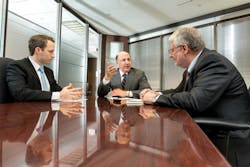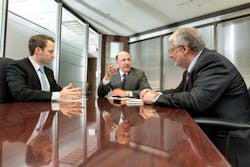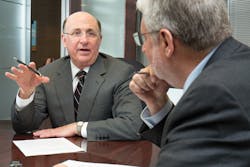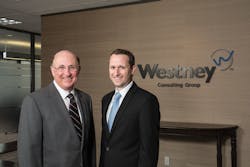WESTNEY HELPS COMPANIES IMPROVE PREDICTABILITY AND PERFORMANCE AND REDUCE FINANCIAL RISK FOR MAJOR PROJECTS
PHOTOS BY SYLVESTER GARZA
EDITOR'S NOTE: OGFJ recently visited with Dick Westney, head of Westney Consulting Group, which he founded in 1978, and Justin Dahl, a principal with the firm, at their offices in Houston's upscale Galleria district to talk about their work and the impact current tough business conditions are having on major industry projects.
OIL & GAS FINANCIAL JOURNAL: Dick, you're a mechanical engineer by training. When and why did you start Westney Consulting Group? Did you have a background in business before launching the firm?
RICHARD WESTNEY: When I was an aircraft designer in the late 1960s, I managed to get a masters of management science degree. This was the early days of operational research and management science where we learned to use mathematical tools to solve management problems. So you might say that is sort of a partial MBA. But up until I started the company, I had no business experience. However, I think my work with Exxon provided the most incredible training a person could possibly have. Even today, Exxon is an industry leader in project management. I had wonderful mentors there and think I was very well prepared to strike out on my own.
In the mid-1970s, I was managing large offshore projects for Exxon. I really loved my work, but decided my true calling was to enable others to succeed in managing major projects that presented significant financial risk. That was the firm's mission then, and today we are still helping companies improve predictability and performance across the capex portfolio.
Our client is typically an executive in an owner/operator or contractor organization, who is faced with a difficult capital project decision and seeks an independent, expert perspective. Our focus is on the risks, strategies, and organizational capabilities for engineering and construction projects - including upstream, midstream, and downstream.
OGFJ: Somewhere along the way, you found time to attend Harvard Business School.
WESTNEY: Yes, but it was well after the business had become successful. The curriculum was designed especially for experienced business people. It sort of told us what to do next.
OGFJ: How about you Justin - what is your background?
JUSTIN DAHL: I have a degree in mechanical engineering from Texas A&M and an MBA from Rice University. Similar to Dick, I worked on projects for about five years for Dow Chemical. For the past five years I've focused my career on consulting, first with McKinsey&Company, and now, of course, as a principal with Westney.
OGFJ: How do you help these executive decision-makers, Justin? What does the firm do?
DAHL: Our work is in two buckets: the first is supporting projects with an independent, expert perspective on project cost and schedule risk, strategic planning, and predictability calibration. The second is in improving the capabilities of the organizations that develop and execute the capex portfolio.
OGFJ: The economic viability of major projects in the oil and gas industry is, of course, seriously challenged today. How has this impacted what you do?
WESTNEY: Any tolerance of cost overruns that may have existed before is now gone. And that tolerance was needed; all the studies agree that past, major projects in the oil and gas industry have been more likely than not to experience significant cost overruns. Offshore projects have had the worst performance.
Now, investing in a major upstream project has to reflect today's hard realities. We cannot expect that a higher oil price will offset a cost overrun. We cannot rely on suppliers and service providers to offset low product price - all the juice has been squeezed out of that orange.
For the engineering and construction industry, the situation today comes down to this: Step change improvements in two areas:
- Given low oil and gas prices, we need to find dramatic reductions in project cost;
- Given the volatility in oil and gas prices, we need to be much more predictable in our estimates of project costs and time to first oil.
The key point here is that capital projects now present a major business risk that project investors need to manage. You cannot count on others to do it for you.
DAHL: To add to Dick's point, there is a focus on certainty of project outcomes that we have not observed in the recent past. We are hearing project sponsors and leaders of project organizations really beginning to convey this message to their teams. The question, of course, is how will these organizations respond and will they be enabled to succeed?
WESTNEY: Just to add a little more to what Justin just said, this whole idea of taking an independent, outside perspective is critical with projects. People need to understand all the risks and to have a plan to mitigate them. Of course there are times when people think they're going to make money no matter what happens. But when they realize they can't afford to get this wrong, such as in the current economic climate, there will be an increased interest in the services we offer, and we benefit from that, of course.
OGFJ: You mentioned that you strive to improve the capabilities of the organizations that you work with in developing and executing their capex portfolios. How do you do this?
DAHL: We do everything from looking at the actual project management organization itself, how it fits with the portfolio of projects, to how that may be changing in the current market. We also look at the processes that support it. We help these organizations get leaner with their processes so they can take a more agile approach to project management. And the final piece is the capability-building. This means finding new, more efficient ways to transfer expert knowledge. We are excited about the new learning methodology we are now using, that combines the latest knowledge acquisition technology with a different, more participatory classroom experience.
OGFJ: Even though the rate of growth has slowed, global demand is still increasing while, of course, production from existing fields inevitably decreases. At some point, investment in new onshore and offshore facilities will have to ramp up. What needs to change if the costs of these new projects are to be reduced and their predictability improved?
WESTNEY: The key point, and one that is often overlooked is this: "Black Swan" risks are not the villains in this story. The truth is, the root causes of high cost and poor predictability are internal. That means, with the right leadership, they can be fixed.
OGFJ: What are some of these root causes - and why do they persist?
WESTNEY: Let's start with the elephant in the room everyone pretends not to see: a bias to optimism and overconfidence. This should not be surprising; it is rational economic behavior for project sponsors, contractors and suppliers, and project managers to quickly embrace an optimistically low project cost, or short project schedule. This may be driven by the sponsor's need to "make the economics work" or the project manager's and engineering and construction contractor's need to have a project to work on. To make matters worse, many executives continue to believe that the way to get good cost performance is to set arbitrarily low cost and schedule targets, in spite of years of experience that demonstrates this actually increases cost, duration and risk. And, to complete the cycle, those who execute projects have a can-do culture that encourages overconfidence that an optimistic cost target can be achieved.
So, of course this dysfunction persists, since everyone has a reason to buy into it.
A second unacknowledged elephant is a different form of overconfidence. This one is overconfidence that "best practices" will ensure project success. Over the past 25 years, large investments have been made in project organizations to design these best practices and enforce their implementation on every project in the capex portfolio. A good example is staged/gated project development processes designed to ensure a project is well defined when the final investment decision is made. Of course this is a good idea, but the problem arises when the organization is taught that adherence to a standard process guarantees success.
While the goal is discipline and consistency, an obvious problem with this approach is that projects vary across the capex portfolio; a deepwater production facility in hostile conditions presents a very different set of challenges than a refinery. And, perhaps even more troubling is that the belief that the most important risks are mitigated when a project's scope and engineering are well defined. While of course that is important, it can reduce the awareness of the other risks that impact project cost, such as what we refer to as strategic risks.
OGFJ: What are strategic risks, and why are they important?
WESTNEY: Well, that is Elephant #3. Here is what happens: A lot of work is done on the planning and engineering, and a cost estimate is prepared. "Contingency" is added to cover the risks a project manager can identify and manage. This estimate is then presented to the board of directors for approval. But, in many cases, strategic risks - those outside the ability of a project manager to manage - are not discussed. These may be external, such as geopolitical risks or the availability of skilled construction labor. They may also be internal, such as a lack of project management capability in the owner/operator organization. In our experience, major projects often fail because these strategic risks were (intentionally or unintentionally) not fully recognized. Nor will they be covered by contingency.
And, of course, if you have not identified a risk, it will not be mitigated.
OGFJ: There has been a lot of talk about the "Great Crew Change", i.e. the loss of experienced engineers and project managers. Is this still a risk that makes projects more costly and unpredictable?
DAHL: It sure is. Just two years ago, there were a lot of projects and the industry was stressed over the lack of experienced engineers and project managers. Now of course, the same industry can't afford to keep all of them employed, and many are being pushed into retirement or other types of work. Of course, as you mentioned, in a few years it is likely there will be a shortage again.
The risk here is costly mistakes - it's what we call "unforced errors in project execution." Engineering and construction is an empirical sort of profession. Every project occurs only once, and every day on a project is different. Many tasks are repetitive of course, and many skills can be taught. But the real challenge will soon be: how do you give inexperienced engineers and project managers the expert judgment they need to know what to look for, when to be concerned and when not to be, when they can believe what they are being told and when they need to investigate.
There's also the issue of what talent project organizations will retain. There has been, and will continue to be in the short-term, significant staffing reductions in project organizations.What isn't always considered is how to make those reductions in a way that helps organizations deliver the projects in their portfolio. Over the years, many specialist silos have been developed - project organizations will need to consider which specialist they can retain and which skills need to be held by contractors. Even more difficult moves will need to be considered, such as training more "project generalists" with a broader cross-functional skill-set to deliver projects.
Everyone knows that continuing to invest in the people you have, even when the market is down, is the right approach. Organizations that are able to identify, retain, and retrain the right people, will certainly emerge as winners when we come out of this downturn.
WESTNEY: That's right. One of the big challenges companies have, in my view, is determining how to put a dollar value on experience. If someone has 20 years of experience on projects around the world, what does that contribute to their ability to be a lead engineer or a project manager or a project director? These are areas of judgment that cannot be taught and are very difficult to pass along to others. So when budgets are being cut and organizations are being downsized, it's sometimes hard to justify the higher cost of having somebody with more experience. So all of us are concerned about what will happen a few years from now when the workload for major projects restarts. Arguably, we'll be in an even worse situation than we've been in the overheated project scenario where the people who had that experience will have retired and are no longer interested in coming back. Also, fewer people at the beginning of their careers may be entering the industry. There will be a lot of people thrust into positions of responsibility who have far less experience. It will be a difficult situation for many companies.
OGFJ: You mentioned that "with the right leadership, the root causes of high costs and poor predictability can be fixed." Who will provide this leadership?
WESTNEY: There's an old saying about the Golden Rule: "The person who has the gold makes the rules." I think that the financial stakeholders - boards of directors, JV partners, investors, and lenders - hold the key. We are certainly entering a time when the level of due diligence and scrutiny of major projects before the final investment decision will be much higher. We've talked about several areas where financial stakeholders can direct attention:
Elephant #1 was optimism and overconfidence - budgets, target completion dates, cash-flow forecasts and economics that are unrealistic. If I were an investor, I would be willing to go to great lengths to ensure the numbers I was looking at were truly unbiased. We don't want to kill good projects, but we also don't want bad projects (that we should have known were bad projects) to kill good companies.
Elephant #2 was over-reliance on best practices. If I were an investor, I would want to be sure that the time and cost of project development and execution were optimized for my specific project, and that people, not a process, were held accountable for the results.
Elephant #3 was inattention to strategic risks. If I were an investor, I would want to be sure that all the strategic risks were identified and plans were in place to monitor threats and adjust strategies as needed. While I would not want to see project budgets inflated with high contingencies, I would want to know where the funds would be found if a strategic risk were to materialize.
OGFJ: How is Westney helping clients to address the issues you mention?
DAHL: As we mentioned, our two focus areas are improving individual projects and improving the organizations delivering those projects. Our "outside-in" look at projects address all three of the issues that Dick mentioned. We perform top-down looks of projects that compare a project estimate and schedule, and the key inputs driving them, to what's really achievable. As an example, we often observe extremely detailed, but unrealistic, project schedules. Project teams have confidence in the tools and the assumptions used to create the detailed schedule, but often don't have the experience or data to ensure that optimism isn't built in. We have the experience, data, and tools to provide that independent perspective.
On the organization-side, we are beginning to help clients think about how to adapt, and this includes helping them to reconsider the framework for how they design and manage projects and what skills are needed within their organization.
OGFJ: Can you provide some additional detail on this new framework that projects are being evaluated by?
DAHL: Given the current environment, everything is on the table to make projects more economic. We've all heard the term "gold-plating" of engineering design, and that, of course, isn't going to work with low oil prices. Engineering design is now considering what is truly needed. As we've heard it put, companies aren't just having to go from gold- to silver-plating, but will have to make tin-plating work. This is a big change. With a new design framework, companies are also reevaluating their project portfolio, even to the extent of looking at projects that were previously turned down that might work with new design requirements.
OGFJ: What common challenges are you seeing organizations face as they adapt to delivering projects in the current low-price environment?
WESTNEY: Besides really looking hard at understanding what project delivery capabilities are needed to execute a particular portfolio, organizations are frequently overlooking effective change management. With slimmed-down organizations and new ways of executing projects, project practitioners are often left with a lot more to do and little direction. Organizations will need to ensure that skills are continually developed, a compelling case for change is made, and that project sponsors are modeling the desired behavior.
OGFJ: Thanks for taking the time to talk with us.
Westney recognized by KRCA
In February, Kennedy Research Consulting & Advisory (KRCA), the most influential market research firm devoted exclusively to the consulting industry, released its 2015 research and advisory report, "Capital Strategy & Capital Projects Consulting." In the report, KRCA looked at the competitive landscape for capital strategy and capital projects consulting and ranked the top 19 firms in the sector. Houston-based Westney Consulting Group is one of the 19 firms named to the list and is one of only four to receive the prestigious Kennedy Vanguard rating.
Here is what KRCA had to say about Westney:
The consummate industry project practioners, Westney turns the traditional S&O (strategy and operations) service delivery model on its head with a standard project team ratio of three senior experts with extensive real world project experience for every associate consultant. Lots of firms advertise this sort of expertise, but Westney is unique for the way in which it cultivates an organizational culture that is conducive to making senior experts the heart of the business model and project delivery. This firm is also distinctive for its risk specialist capabilities and laser-like focus on helping its clients to understand the real sources of risk in their projects, rather than going through the risk modeling motions. Although it is expanding its offerings, Westney continues to exhibit the most strength in oil & gas where its roots lie.




